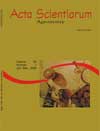Genetic diversity and efficiency in predicting sweet pepper (<em>Capsicum annuum</em> L.) hybrids behavior
Abstract
The genetic diversity among six sweet pepper lines in relation to eight growth and nutritional traits was evaluated by multivariate analysis techniques (Mahalanobis’ D2ii' distances, Tocher’s grouping analysis and dispersion graphic analysis). Based on the D2ii' distances estimated, the relation between predicted genetic dissimilarity and the hybrid total dry matter mean, heterosis and specific combining ability in the F1 hybrids, was also evaluated by Pearson’s and Spearman’s correlation coefficients. There was a wide genetic variability, evidencing the lines P-141-152-F14, P-142-403-F11 and P-141-190-F16 by dissimilarity between themselves and in relation to the group. Positive (>0,50) and significant correlation coefficients (P < 0,05) were detected between D2ii' and heterosis and specific combining ability, indicating that the genetic distance, estimated by multivariate procedure, is a highly efficient methodology for choosing promising combinations in breeding programs.Downloads
Download data is not yet available.
Published
2008-07-14
How to Cite
Oliveira, V. R., Scapim, C. A., & Casali, V. W. D. (2008). Genetic diversity and efficiency in predicting sweet pepper (<em>Capsicum annuum</em> L.) hybrids behavior. Acta Scientiarum. Agronomy, 20, 263-267. https://doi.org/10.4025/actasciagron.v20i0.4354
Issue
Section
Agronomy
DECLARATION OF ORIGINALITY AND COPYRIGHTS
I Declare that current article is original and has not been submitted for publication, in part or in whole, to any other national or international journal.
The copyrights belong exclusively to the authors. Published content is licensed under Creative Commons Attribution 4.0 (CC BY 4.0) guidelines, which allows sharing (copy and distribution of the material in any medium or format) and adaptation (remix, transform, and build upon the material) for any purpose, even commercially, under the terms of attribution.
2.0
2019CiteScore
60th percentile
Powered by 

2.0
2019CiteScore
60th percentile
Powered by 



















































